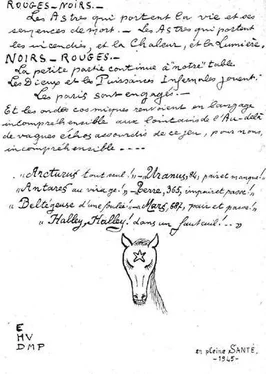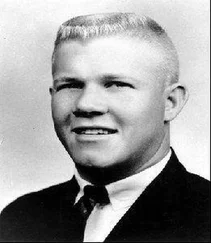On one visit to rue Le Sueur with his secretary, Canitrot; his deputy, Battut; Dr. Paul; the examining magistrate, Georges Berry; and several other inspectors, Massu drove up past a crowd of about one hundred spectators on the sidewalk. The first stop was the pit, which was still ghastly, despite the fact that the gravediggers had already sifted through the remains and the firefighters, on Massu’s instructions, had aired out the surrounding coach house. Indeed, the forensic team had now scraped the bottom of the pit and retrieved the last lime-coated “debris of bones and bundles of muscles.”
Massu showed the inspectors the triangular room, or “torture chamber,” as the press had dubbed it. The wallpaper had been peeled and the thick walls had been examined for other decoys or secret rooms. Massu said that he knew the macabre room better than his own bedroom. Except, of course, the commissaire still did not fully understand its significance.
To demonstrate the Lumvisor viewer, named after the German company that manufactured it, Massu asked his secretary to stand near a pair of iron hooks in the “field of vision” and then went to the adjacent room to take a look. The hole was above his height, but when he stood on the electric heater, which was placed directly underneath, he could look into the lens. His eyes fell right on the face of his secretary. When he checked the range of the device, the view did not shift more than a few centimeters either way. Massu imagined the victim, incapacitated, perhaps drugged, and then hanging there, suspended by the hooks, while the doctor watched every move of the victim’s face in magnified perspective.
One magistrate asked Massu how Petiot killed his victims. The commissaire explained that the police had found no trace of blood in the room, and the forensic experts had thus far found no evidence either of stabbing, shooting, or strangling. Massu was inclined to think of poison, injected perhaps in the guise of being anesthesia or medicine. But with the lack of viscera for examination, toxicologists had found no trace of poison. Was there perhaps another method that Petiot used that eluded detection? Massu was still, as he put it, “reduced to hypotheses.”
Another official asked about the last moments of life, where the survival instinct took control, resulting in a final, desperate fight for existence. But again, the triangular room showed no signs of struggle. The group, no strangers to horror, turned silent on yet another mystery in the case.
Asked about the events after the murder, Massu explained that Petiot probably took the victim’s body across the courtyard to the basement. The high walls he had constructed would have shielded him from the view of his neighbors. At the kitchen workstation in the basement, he probably scalped and disinterred the corpse. He used the two large and deep sinks, joined by a slender draining table that was stained a dark red or brownish tint. The entire setup, which rested against the tiled wall, was certainly large enough for this work. Water could flow across the draining board and then into the second sink, where a side container was placed. The drain under the larger, higher sink, police had discovered, led directly to the sewer.
At one point during the visit, Dr. Paul approached the commissaire, grinning, his hand extended. Massu knew that the forensic expert often added a few details in person that he did not insert into his report. Sure enough, Paul had some news. “It’s like two years ago,” he said. Paul was referring to a period between May 1942 and January 1943 when a number of arms, legs, torsos, and other body parts had been fished out of the Seine or dropped in parcels around town.
The first of these packages had been found on May 7, 1942, when a trunk, tied with a rope, had been hauled out of the Seine under a bridge near a canal at Saint-Ouen. It contained a body of a male approximately forty-five to fifty years old without head, hands, or feet. The head had been removed, the police report detailed, “at the level of the neck, with a sharp cutting instrument, just short of the shoulders.” The hands had been cut off at the wrist, or the radioulnar carpal joint, the feet just below the shin, at the tibiotarsal joint. Apart from the dismemberment, there was no scar, fracture, or “trace of violence.” The body was never identified.
There would be many other horrific finds over the next eight months: July 2 at Neuilly, just outside the 16th arrondissement; August 6 at Asnières, northwest of the city center; August 10 at Saint-Denis, north of the center; August 19 again at Asnières; and so on. On August 22, 1942, investigators found a trunk on the northwest outskirts of Paris, at Courbevoie, containing two human hands without skin or fingertips, two feet without toenails, the skin of two legs including the heel, and three scalps, the first with reddish-blond hair, the second almost black, and the third gray. There was also a chest wall, a left ear with part of the skin of the face, the point of a nose without any cartilage, a penis with two testicles in a lacerated scrotum, and an entire face mask, with the point of a nose, mouth, lips, and both ears. Four other mutilated fragments of human bodies could not be identified.
Bodies and body parts continued to emerge from the Seine in bulging trunks tied shut with ropes. In each find, the decapitation and dismemberment had been expertly administered, the perpetrator wielding his scalpel like “a man of the lecture hall.” What’s more, each one was treated in a strikingly similar way.
As far as authorities could tell from the recovered body parts, the hair was shaved, the eyebrows were removed, and the face mask peeled away in a single smooth cut. Even the fingerprints on the severed hands had been meticulously filed off or dosed with acid. Everything was done with such skill and precision that Dr. Paul had more than once feared that someone on his own staff had been committing the murders.
But Dr. Paul saw something else in the dissection and dismemberment. He explained:
We forensic scientists are in the habit, in a dissection, of not passing our scalpel on the table of operation when we stop in the middle of our work, but instead stick it in the thigh of the cadaver
.
He had found such marks on the first find of human remains in May 1942 and then on many others pulled from the Seine—four thighs alone, for example, on October 4, 1942. He had seen those marks again in the “shreds of flesh” sent over to him from the lime pit. He suspected that this was the work of the same man, a well-trained physician who was also remarkably talented at covering his tracks.
While the police looked around rue Le Sueur, a number of reporters had joined the crowd outside the town house, swarming, Massu thought, like “a storm cloud of mosquitoes.” They could not wait to question the commissaire. How many victims were there in the case? Were there really fifty murders, as some newspapers were now reporting? What other accomplices, if any, were involved, and what had been decided about Madame Petiot? Could the commissaire confirm that the murderer was scalping his victims and decorating his basement with a sinister ring of skulls?
Did Petiot really have a folio copy of the Marquis de Sade with a cover made of human skin? What about the rumor that the killer, before finishing off the victim, donned a frightening rubber mask? The reporters, eager for any tidbit of information, virtually blocked Massu’s path to the car. The commissaire felt like he was throwing crumbs to pigeons outside Notre Dame.
“Is it tomorrow, then, that you will arrest the doctor?” one reporter asked Massu. Where was Petiot, and why had he still not been found? The press, impatient for more details, was exerting a considerable amount of pressure on the Brigade Criminelle. Paris was devouring the tale of horror in the heart of this chic neighborhood.
Читать дальше












